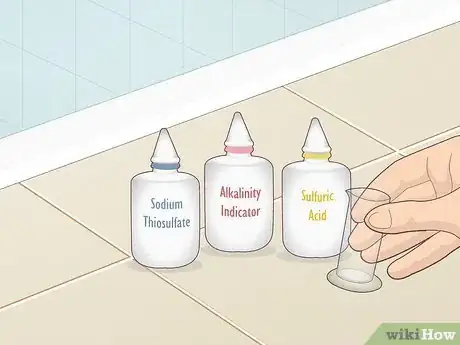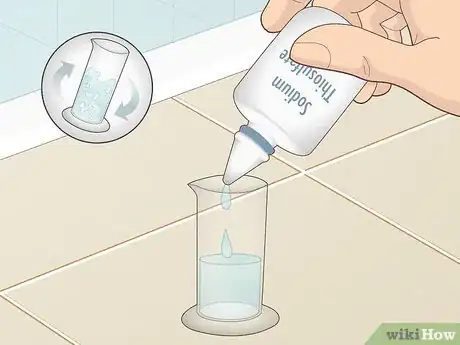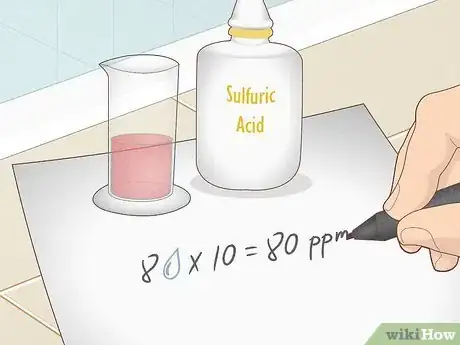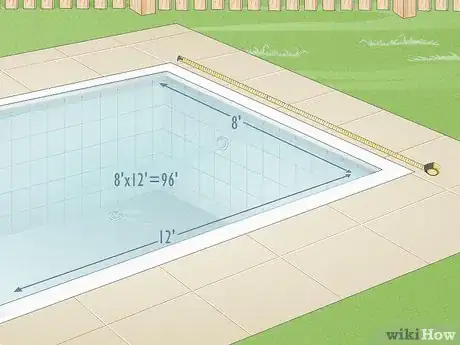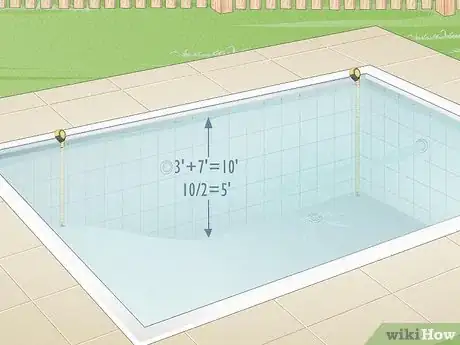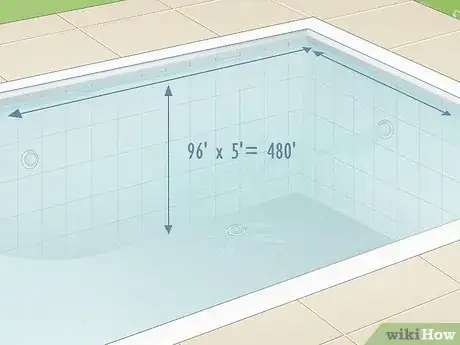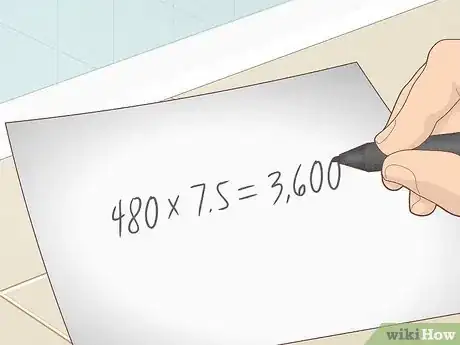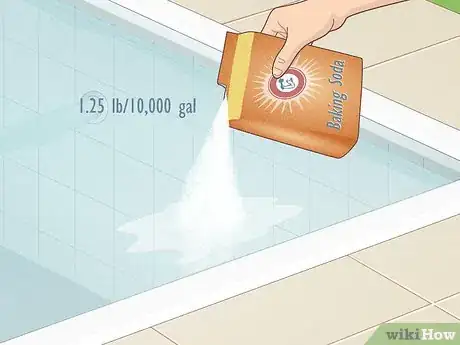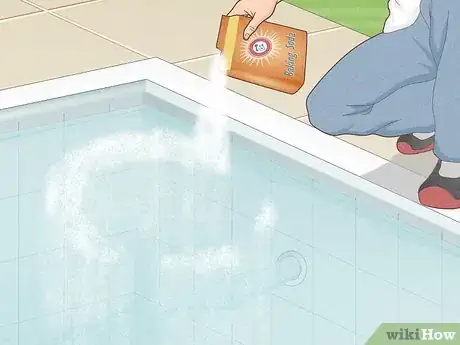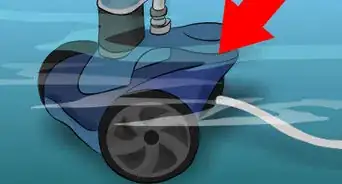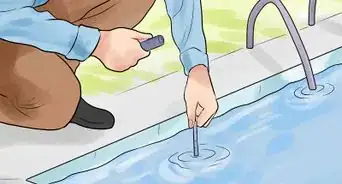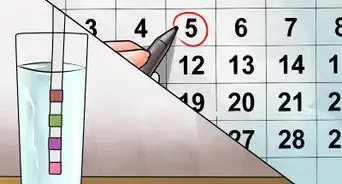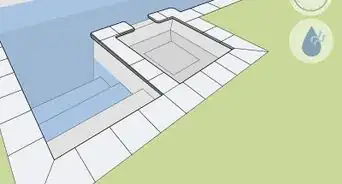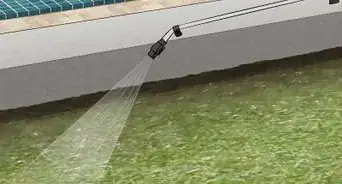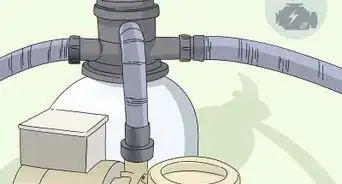This article was co-authored by wikiHow staff writer, Hunter Rising. Hunter Rising is a wikiHow Staff Writer based in Los Angeles. He has more than three years of experience writing for and working with wikiHow. Hunter holds a BFA in Entertainment Design from the University of Wisconsin - Stout and a Minor in English Writing.
There are 7 references cited in this article, which can be found at the bottom of the page.
This article has been viewed 82,965 times.
Learn more...
Adding baking soda to your pool raises the pH level, keeping the water clean and safe to swim in. The amount you add will depend on a few factors, such as the alkalinity of the water, the pool's volume, and even what temperature the water is. Once you get these basic measurements, though, you can mix in your baking soda and you'll be ready to dive in and go for a swim in no time!
Steps
Testing the Alkalinity with a Kit
-
1Purchase a titration test kit. Titration test kits are a thorough measurement system for testing the alkalinity in your pool. They can be purchased in pool specialty stores or online.[1]
- You can also use alkalinity test strips, though they do not have an accurate reading system.
-
2Take a water sample from your pool at elbow depth. Dip the tube provided in the kit into the water. Pulling water from this depth ensures that the water has not been altered by anything in the air or by sunlight.[2]
- You only need 25 millilitres (0.85 fl oz) to complete the test. Remove any excess water from the tube.
Advertisement -
3Add 2 drops of the sodium thiosulfate. Squeeze the tube gently so you don't use too many drops. An incorrect amount of sodium thiosulfate will alter the results. Make sure the mixture is swirled around so the water and chemical are mixed thoroughly.[3]
-
4Put in 5 drops of the alkalinity indicator and swirl the tube. You'll notice the water change colors from clear to green. Keep swirling the tube until the color is consistent throughout the tube.[4]
-
5Add the sulfuric acid reagent 1 drop at a time until the liquid turns red. After each drop, mix the water. Count the number of drops you add to the water. Once the solution turns red, stop adding sulfuric acid.[5]
- Wear gloves as you handle the sulfuric acid in case you spill.
-
6Multiply the number of drops by 10. This will give you the parts per million (ppm) of alkalinity in your pool water. A pool should be between 80-100 ppm. Anything lower could affect the pH of the pool while anything higher could cause scaling to develop.[6]
- If your alkalinity is higher than 100 ppm, do not add baking soda to the water. Instead, add muriatic acid or sodium bisulfate.
Measuring Your Pool's Volume
-
1Find the length and width of your pool to find the surface area. Use a measuring tape to determine the length and width of your pool if you don't already know the dimensions. Multiply the 2 numbers to find the total surface area. This process is easiest for a rectangular pool.[7]
- For a circular pool, measure the diameter of the pool and divide it by 2 to find the radius. Square the radius and multiply the number by pi (π).
- For a triangular pool, multiply the length of the base and the length from the base to the furthest point of the triangle. Divide the result by 2 for the surface area.
- If you have an irregular shaped pool, you'll have to find the averages for each measurement. Measure the shortest and longest lengths and add them together. Divide the answer by 2 to find the average length. Repeat the process to find the average width.
-
2Average the depth of the shallow end and the deep end. Run a tape measure down to the bottom of the water at both ends of your pool. Once you find the shallowest and deepest point, add the depths together and divide by 2 to find the average depth of your pool.[8]
- If your pool is the same depth throughout, you do not have to take an average measurement.
-
3Multiply the surface area and depth to find the volume. Once you have your two figures, multiply them together to find the volume of your pool. This will either be in cubic feet or cubic meters depending on your measurement system.[9]
-
4Multiply the volume by 7.5 for cubic feet or by 1,000 for cubic meters. There are 7.5 US gallons in 1 cubic foot, but there are 1,000 liters (260 US gal) in 1 cubic meter. Multiply the volume dependent on your measurement system to find the amount of water in your pool.[10]
Mixing in the Baking Soda
-
1Add 1.25 lb (570 g) of baking soda per 10,000 US gal (38,000 L) of water. This will raise the alkalinity of the water by 10 ppm. Adjust the values to determine how much baking soda you need to add for the volume of your pool.[11]
- For example, if you want to go from 60 ppm to 80 ppm in a 10,000 US gal (38,000 L) pool, you would add 2.5 pounds (1,100 g) of baking soda.
-
2Use only 2 pounds (910 g) of baking soda per day. Adding too much baking soda to the water at a time could raise the pH of the water. Let the baking soda settle and mix with the water before adding more.
- If you need to raise the alkalinity further, wait until the next day to add more baking soda.
-
3Pour the baking soda into the deep end of the pool. Use a circular motion as you pour the baking soda. It may cause some cloudiness in the water initially. The baking soda will sink to the bottom of the pool and settle before it begins mixing.[12]
- To avoid cloudiness in the water, pour the baking soda directly into the skimmer.[13]
-
4Retest the water after 10 hours and make further adjustments if necessary. Your pool water needs to pump and circulate through a full cycle before you retest the water. Check the alkalinity using your test kit.[14]
- Let the pool run for a full pump cycle, which takes about 10 hours, before swimming.
- If your alkalinity levels are still off after the first baking soda treatment, add more baking soda to reach the desired ppm.
Things You'll Need
- Tape measure
- Titration test kit
- Baking soda
- Measuring cup
References
- ↑ https://poolforthought.com/testing-pool-alkalinity/
- ↑ https://poolforthought.com/testing-pool-alkalinity/
- ↑ https://poolforthought.com/testing-pool-alkalinity/
- ↑ https://poolforthought.com/testing-pool-alkalinity/
- ↑ https://poolforthought.com/testing-pool-alkalinity/
- ↑ https://poolforthought.com/testing-pool-alkalinity/
- ↑ http://tillamookchc.org/wp-content/uploads/2016/06/FormulasForPoolCapacity_04-24-02.pdf
- ↑ http://tillamookchc.org/wp-content/uploads/2016/06/FormulasForPoolCapacity_04-24-02.pdf
- ↑ http://tillamookchc.org/wp-content/uploads/2016/06/FormulasForPoolCapacity_04-24-02.pdf
About This Article
For an easy way to increase the alkalinity in your pool, add 1.25 pounds of baking soda for every 10,000 gallons of water, which will raise the alkalinity by 10 parts per million. To keep the water from getting cloudy, pour it directly into the skimmer at the deep end of the pool, and let it settle to the bottom where it will mix into the water on its own. If you need to raise the alkalinity further, wait till the next day to add more baking soda, since adding too much at a time could raise the water’s pH. To learn how to retest your water after the baking soda treatment, scroll down!
